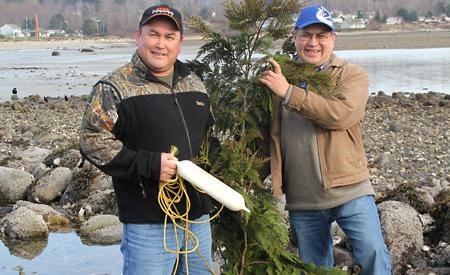Coastal residents didn’t know they were witnessing history when an armada of herring boats cast their nets in front of Powell River in the early 1980s. As fishers pulled in tonne after tonne of herring, they counted dollars, but no one calculated the price that would be extracted on the run, which had sustained an aboriginal population for thousands of years.
Adult herring move in vast schools, often many kilometres long, and migrate annually to shallow waters to spawn. Males release milt that fertilizes the thousands and thousands of eggs produced by females. The milt turns the water white and the eggs cling to eel grass, rocks or any other available shelter to hatch. Herring spawn triggers a feeding frenzy among marine birds and mammals and the coast springs to life, vibrating with energy.
Each spring for more years than scientists can count, Tla’Amin (Sliammon) First Nation people would watch and prepare for the event which occurred anywhere from the end of February to mid-March. As herring spawn, they form huge, roiling balls, designed to provide protection from predators. Aboriginal people would go out in their canoes with herring rakes, long cedar sticks that had spines in them, to sweep through the herring ball and snag the small fish.
Roe was collected on cedar boughs, anchored in intertidal zones. After the spawn, community members gathered the boughs, now laden with thousands of eggs, and hung them to dry in the sun and wind.
Two Tla’Amin community members believe their generation will be the last to have witnessed the herring spawn and community activity surrounding it. Roy Francis, 51, and Lee George, 47, are brothers who grew up on the waterfront in Tla’Amin. They remember the herring spawn in Scuttle Bay, one of the major gathering areas. “It was easy to go out there at low tide, lay out your cedar boughs, anchor them to the bottom and go out there and share in the big community event,” said George, who is the manager of the Sliammon Salmon Hatchery.
In the intertidal area in front of Tla’Amin, fish traps that have been there for thousands of years stand as a reminder of ancient ways that still work. Francis and George remember herring rushing to shore during the spawn and how the fish were caught in the fish traps. “When the tide went out, we’d be out there harvesting the herring,” said Francis, Tla’Amin’s chief treaty negotiator.
Children were taught rules when they were collecting the spawn, Francis said. “One of those rules is that you have to be respectful and quiet. You can’t disturb the herring when they’re spawning, for example by banging on the bottom of the boat. The warning was the herring wouldn’t come back if they were disturbed.”
In 1983 and 1984, a commercial herring-roe fishery changed everything. Herring seiners moved in and left with 3,200 tonnes of herring the first year and 4,000 tonnes the following year.
After the commercial fishery, Francis said, he’s never seen herring in the fish traps again. Before the fishery, there was more than enough herring for people and wildlife, but now “we’re competing with one another,” George said.
Tla’Amin people have a knowledge about herring, when they spawn and what their behaviour was, Francis said. Yet, Fisheries and Oceans Canada (DFO) biologists argue there is no such thing as resident herring stocks. “They believe they spawn in our area by accident and they travel and spawn in different areas throughout their lives. We think they’re wrong, we know they’re wrong. Their information is a lot different than ours.”
Tla’Amin community members have to go to Denman Island with their cedar boughs, with no guarantee that they’ll return with roe. What little they bring back is a treat for the elders, whose faces light up as they taste their traditional food.
His generation is seeing the end of a species, Francis said. “It’s really sad to think that way, but we’re witnessing it.”
George said he believes if stocks were left alone, fish would eventually come back. “Let them repopulate. Right now there is an imbalance. There isn’t enough for everybody.”
Another idea is to restock the area, using traditional knowledge from up and down the coast of people moving roe and cultivating it. That’s one possibility that is part of a major initiative on herring that is emerging from the Hakai Network for Coastal Peoples and Ecosystems, which sprang from a collaboration between the Heiltsuk First Nation of Bella Bella and Simon Fraser University. The Herring School is one of the programs within the network and Tla’Amin is one of the areas that is a focus of the project. Dana Lepofsky, a Simon Fraser University archaeology professor, is involved with the program, as well as continuing the university’s partnership with Tla’Amin.
Lepofsky became aware of the herring decline in Scuttle Bay when she came to Powell River for field studies. The first thing people spoke to her about was how the bay was the place of herring, how it is no more and the frustration around DFO not recognizing the loss of the local population and how critically important it was to them.
Oral traditions are clear about the longevity of the herring spawn, said Lepofsky, and the archeological work shows thousands of years of consistent herring use in Scuttle Bay. “It’s not debatable. We’re talking about thousands of people over the millennia.”
As Lepofsky picked over thousands and thousands of herring bones day after day, the issue became clear. “This is about conservation, conservation of archaeological sites, conservation of the herring resource, conservation of culture.”
Lepofsky wants to talk to people in Powell River about any stories or observations of herring. People can contact her at 1.778.782.5403.
Lepofsky and Michelle Washington, Sliammon Treaty Society land use planning coordinator, are giving a joint presentation about the archaeology project at Vancouver Island University on Thursday, March 10.



